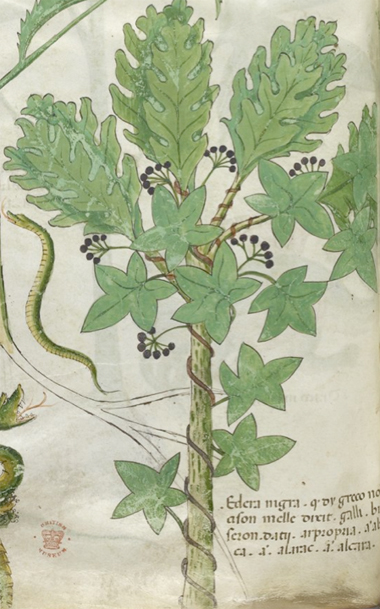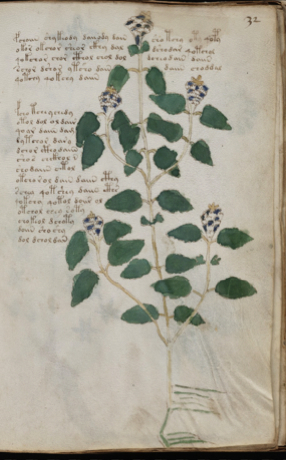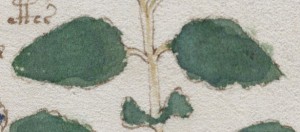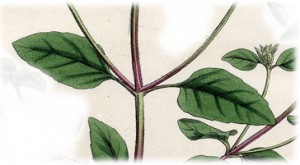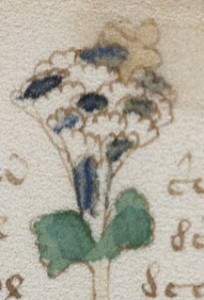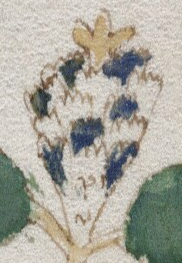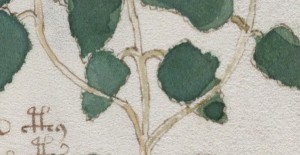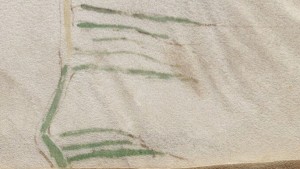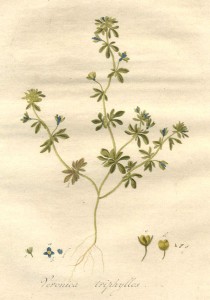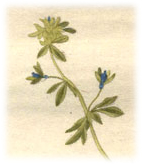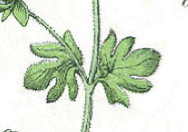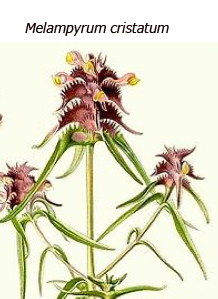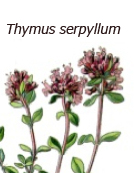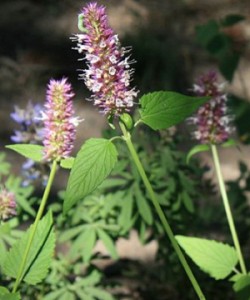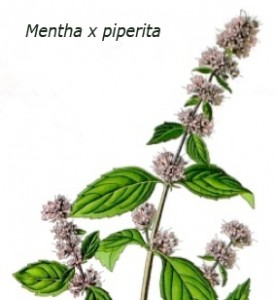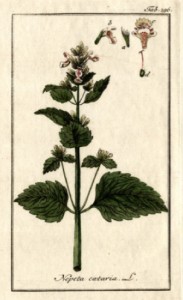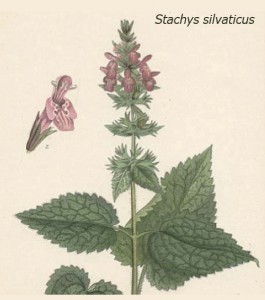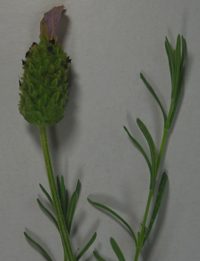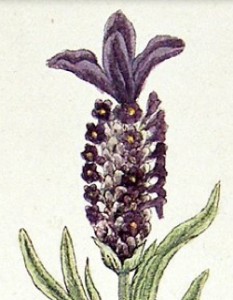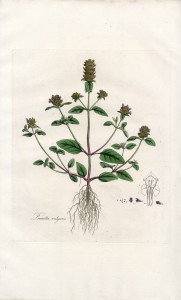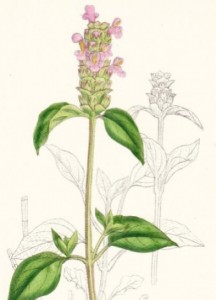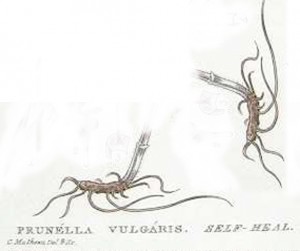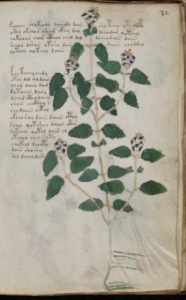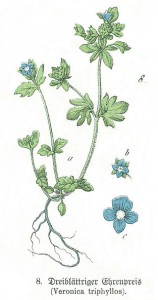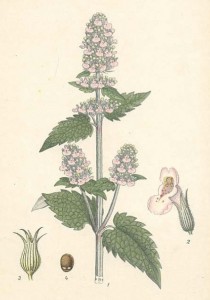Monthly Archives: July 2013
Large Plants – Folio 36r
Voynich Large Plants – Folio 35v 21 July 2013
The VMS plants are more detailed than many herbal drawings of the 15th century, but this has not made identification easy. Some appear identifiable at first glance while others require study. The text is not helpful because, as yet, it has not been deciphered and even once it is, there’s no guarantee the text has anything to do with plants.
Description
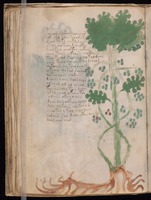 It would take far too much space in one blog to trace herbal traditions that precede the VMS that may have influenced the way the plants were drawn but, at the risk of making even this post too long, I would like to offer an observation about the plant on folio 35v, which suggests, along with other clues, that the Voynich illustrator was familiar with some of the traditional texts.
It would take far too much space in one blog to trace herbal traditions that precede the VMS that may have influenced the way the plants were drawn but, at the risk of making even this post too long, I would like to offer an observation about the plant on folio 35v, which suggests, along with other clues, that the Voynich illustrator was familiar with some of the traditional texts.
Folio 35v shows a tall plant stretching from the top to the bottom of the page, with roots that reach almost all the way from left to right. There is either a single block of text on the left, or two blocks closely spaced.
The crenelated green leaves on the trunk of the central stalk, and at the top, resemble oak leaves and the roots are reddish brown. The central stem and the winding stem are roughly painted a slightly lighter shade of green.
If you look at it a little more closely, you can see that there may be two plants on this page. I’ve mentioned this possibility in my description of Plant 49r, as well—that the Voynich images are not necessarily all drawings of single plants.
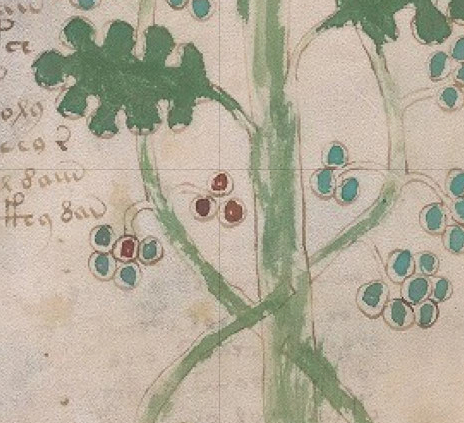 What appears to be a second plant winds its way around (and through) the trunk of the taller plant and has berrylike clusters at fairly regular intervals. The knobs are mostly aqua-blue, a color that doesn’t occur often in the VMS. A few are a slightly darker blue or red. Note that the berries are painted more carefully than the trunk and vine stems, as though the lighter ring around the edge was intentional.
What appears to be a second plant winds its way around (and through) the trunk of the taller plant and has berrylike clusters at fairly regular intervals. The knobs are mostly aqua-blue, a color that doesn’t occur often in the VMS. A few are a slightly darker blue or red. Note that the berries are painted more carefully than the trunk and vine stems, as though the lighter ring around the edge was intentional.
It’s possible that this is some kind of vine and perhaps the tree in the center is a host (either in the sense of providing a support for growth or in the sense of a parasitic host).
It’s difficult to identify the vine from a handful of berries. They might be grapes, they might be something else, they might be buds rather than berries. Also, notice the absence of leaves. In my post on Cuscuta, I suggested the vine might be paired in the drawing with its host plant. That’s possible here too. It’s also possible that the leaves drop in the fall while the berries remain. There are many plants that can be seen in winter with berries and no leaves. There’s simply not enough information to know, unless… we get some help from herbal tradition.
The Twining Vine
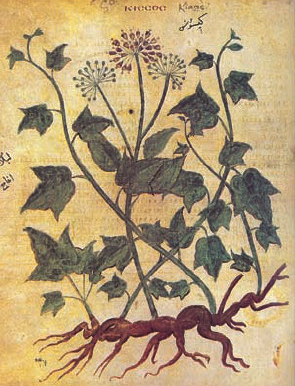
A vine from the Juliana Anicia Codex that follows the same basic format as that of De Materia Medica of, Dioscorides.
Assuming for a moment that the twining plant is a vine and that the round knobs are berries rather than buds, we can look at other depictions of vines in the old herbals to see if any are similar. What we discover is that some are thickly matted, some twirl in one direction tight against the host stem, and some wriggle through the air toward the top or side of the page (e.g., Pseudo-Apuleius). Most have leaves, or leaves and flowers, but some are shown with berries. Harley 4986 differs from most by emphasizing the berries, but doesn’t otherwise resemble Plant 35v.
So it would seem, at first glance, that the VM plant doesn’t follow previous traditions unless we delve a little further.
Herbals Originating from Other Regions
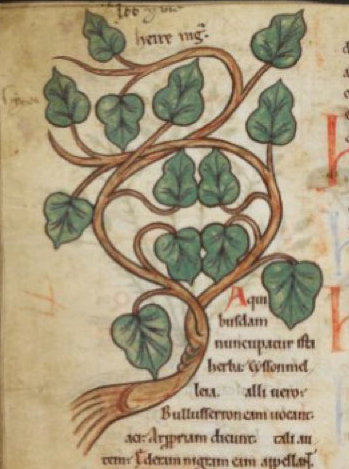 There is a picture of common ivy in Harley 4986, in which the berries are emphasized to the point of looking like grapes, but the drawing is not otherwise similar to Plant 35v—it includes leaves, doesn’t noticeably twine, and doesn’t include a host. Morgan M.873 twines the vine around the host and includes berries but doesn’t show any leaves on the host.
There is a picture of common ivy in Harley 4986, in which the berries are emphasized to the point of looking like grapes, but the drawing is not otherwise similar to Plant 35v—it includes leaves, doesn’t noticeably twine, and doesn’t include a host. Morgan M.873 twines the vine around the host and includes berries but doesn’t show any leaves on the host.
In Harley 1585 (pictured left), an herbal manuscript from the Florentine area, and Ashmole 1462, (copied from H. 1585), there is a vine worth noting because it almost forms a figure-8, but it’s not a great match for the vine on Folio 35v in other ways, even if it’s closer than the ones previously mentioned.
Herbals That May Have Influenced the VMS
 In Liber de herbis et plantis an extensive, well-constructed herbal from the 1300s, we find a number of features that might have inspired Plant 35v. The vine twines around a host, there are clumps of dark-colored berries and, an important detail, the host has crenelated oak-like leaves. Plant 35v resembles the Liber de herbis diagram in many ways.
In Liber de herbis et plantis an extensive, well-constructed herbal from the 1300s, we find a number of features that might have inspired Plant 35v. The vine twines around a host, there are clumps of dark-colored berries and, an important detail, the host has crenelated oak-like leaves. Plant 35v resembles the Liber de herbis diagram in many ways.
The ivy in Sloane 4016, a carefully drawn herbal from c. 1440, is presented in the same way as Liber de herbis except for the shape of the leaves and is probably copied from it or a source common to both.
The biggest difference between Plant 35r and the drawing in Liber de herbis, is that the VMS plant includes roots and does not include leaves. The other significant difference is double-vine twining from opposite directions around the host. Since it seems unlikely that the VM illustrator would concidentally use an oak-leaved host that is drawn so similarly to the one in Liber de herbis, we can surmise that he may have seen this drawing or one of the herbals it inspired.
Could the VMS Plant Have Been Independently Conceived?
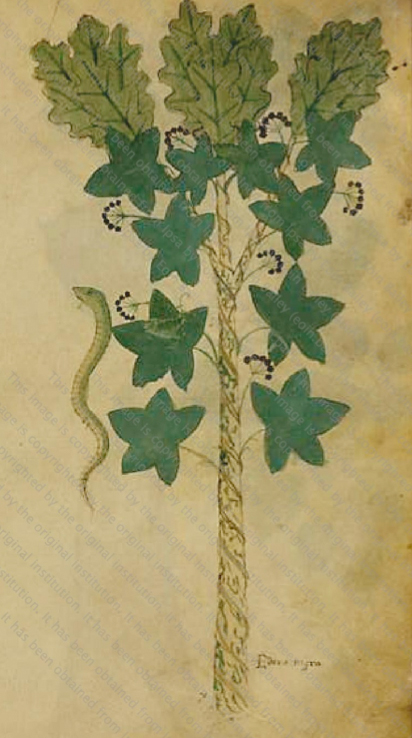 The VMS Plant is difficult to identify without leaves or a label, so we don’t know for sure if it is Hedera. One could argue that the vine in the VMS might be one that is attracted to oak trees, as poison oak is in North America, but it follows the same conventions as the vines depicted in other European medieval herbals and they are all labeled Hedera (usually Hedera helix or Hedera nigra) and Hedera species are quite happy to climb any vertical surface that is near the young plant.
The VMS Plant is difficult to identify without leaves or a label, so we don’t know for sure if it is Hedera. One could argue that the vine in the VMS might be one that is attracted to oak trees, as poison oak is in North America, but it follows the same conventions as the vines depicted in other European medieval herbals and they are all labeled Hedera (usually Hedera helix or Hedera nigra) and Hedera species are quite happy to climb any vertical surface that is near the young plant.
Since Hedera is not parasitic, it can sink its hooks into almost any host, including a bare wall, and isn’t specifically attracted to oak trees. Thus, the choice of an oak-leaved host in the drawings is more likely to be based on herbal tradition than the propensity of the plant.
Herbal Tradition or Original Work?
Sloane 4016 (left) was created around 1440 and probably post-dates the Voynich Manuscript, but its forerunner Liber de herbis et plantis, probably predates the VMS by several decades.
If Liber de herbis influenced the VMS, it’s natural to ask where it was created.
It originated in the southern Holy Roman Empire in the region of Lombardy, land of the “long beards.” The kingdom of Lombardy went into decline but still stretched from the Piedmont region in the west to Austria in the east during the late 14th and early 15th centuries. Italy as we know it didn’t exist until the later 1800s. Some researchers have categorized herbals from this time and place as “northern Italian herbals” but I prefer to think of them as Lombardic.
Is Plant 35v intended to be a Hedera species? We don’t know. It’s noteworthy that Hedera has a darker more roughly-textured knob in the center of each berry such that light reflects more readily off the smoother surface around it. Could this account for the way the berries in the VMS are drawn with lighter rings around the edges?
Was the VMS influenced by Lombardic herbals? Possibly.
Based on extensive observation of the VMS document and its various drawings, I’m inclined to think the author of the VMS was a creative person who danced to a different drummer—either someone from a different culture who brought along a fresh viewpoint, or an individual with a unique way of seeing things. If the illustrator based the drawings, in part, on other herbals, it’s difficult to know for sure, as they have not been slavishly copied, and that is part of its attraction. If the drawings were standard copies of earlier work, there would be less of a mystery, and less to explore.
J.K. Petersen
——————————————————————————————————————-
Postscript, 12 Feb. 2016:
There is something I appear to have overlooked when I first wrote this article. I didn’t include the ivy drawing in Egerton 747 because I initially perceived it as a different style of drawing. It’s a twining example of Hedera nigra, but it doesn’t twine around an oak-like tree. Or does it?
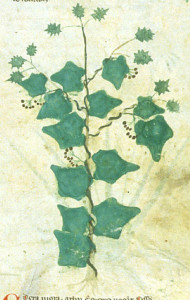 Let’s look at the drawing more closely. You’ll notice that it’s two plants and that it’s twining around something that looks like an upright shrub with deeply serrated leaves. Some herbals show ivy twining around a bare trunk. In nature, Hedera will twine around almost anything. In this picture, the leaves of the host plant are quite small, which is why I initially assumed there was no relationship between Egerton 747 and the herbals that show a larger oak-like plant as the host.
Let’s look at the drawing more closely. You’ll notice that it’s two plants and that it’s twining around something that looks like an upright shrub with deeply serrated leaves. Some herbals show ivy twining around a bare trunk. In nature, Hedera will twine around almost anything. In this picture, the leaves of the host plant are quite small, which is why I initially assumed there was no relationship between Egerton 747 and the herbals that show a larger oak-like plant as the host.
Recently, I realized that a later artist might interpret the deeply serrated leaves as crenelated leaves and may have morphed the concept in Egerton 747 into the oak-like tree in the other herbals, especially if the artist lived in an area with oak trees.
Egerton 747 is one of the early herbals, thought to have been created between c. 1280 and c. 1310 for use as a physician’s reference, and is known to have influenced some of the later herbals. Whether it influenced the style of drawing that led to the oak-like leaves is difficult to know, but the possibility should be considered and perhaps the text that accompanies some of the illustrations can help sort it all out.
© Copyright 2013 & 2016 J.K. Petersen, All Rights Reserved
Large Plants – Folio 35r
Large Plants – Folio 34v
Large Plants – Folio 34r
Large Plants – Folio 33v
Voynich Large Plants – Folio 33r
This plant ID was visible for about a week in 2013, but I took it down (along with numerous others), because I was concerned about giving away too much of my research. As with many Voynich newbies, I thought I was on the verge of cracking the VMS. I now know the challenge is much greater than I anticipated.
What follows is the original post from 2013, but I have converted the pics to .png and added a May 2019 chart to illustrate my choices because I discovered over the years that my favorite ID has never been mentioned by anyone else. The popular favorite is Papaver (even a Finnish botanist suggested Papaver), but I don’t think it’s Papaver.
As a lone voice crying in the wind, I was worried there might be resistance to my idea if I didn’t add some good illustrations, so I have posted an addendum at the bottom…
VMS Plant 33r
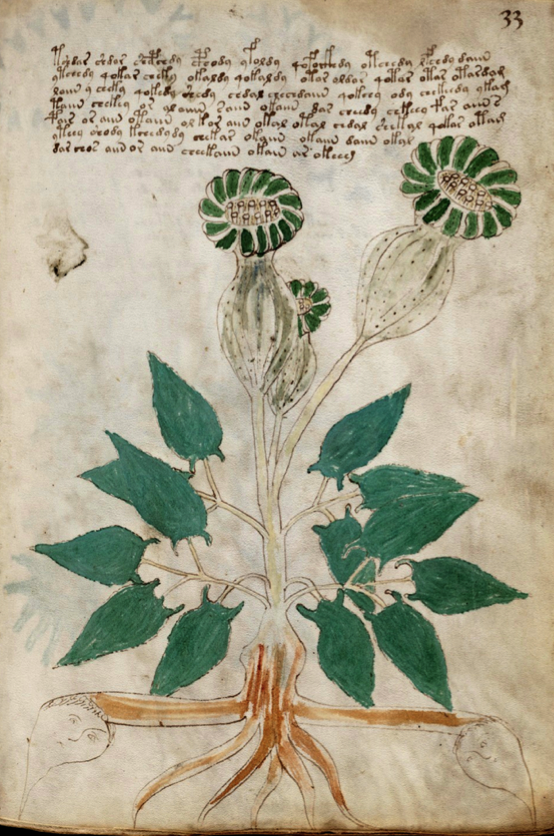 Plant 33r inhabits most of the space on the folio except for seven lines of text.
Plant 33r inhabits most of the space on the folio except for seven lines of text.
Seed Heads
The plant is topped with slightly rotating rosettes on swollen seed capsules (I might be wrong, but I don’t think they are flowers). There are slight vertical striations in the capsules and dots that might be an indication of texture or shadow. One of the capsules is sightly obscured behind another.
The top of the capsules have been painted in alternating green against the color of the vellum, and the lower portion is lightly washed with a bluish-gray, a color not often seen in the VMS (might it mean that these are dried before use?).
Leaves
The hastate leaves are close to the base and spread around the stem somewhat. They have smooth margins and are painted a fairly solid medium-dark green. Hastate leaves are similar to arrowheads. If the points are exaggerated, then it’s also possible the leaves are sagittate, so I tried to keep both of these shapes in mind when thinking about IDs.
Stems
The stems are moderately sturdy, painted with a very pale wash. They get thinner and branch toward the leaves. A couple of the bottom ones are slightly arched downwards. I wonder if this is an attempt to suggest a rosette of leaves around the stem.
Roots
The roots have a thickened portion in the middle, medium-thick tendrils reaching down and out, and two even-thicker tendrils or rhizomes spreading to the sides and terminating in two heads that look to me like tonsured monks. Hair styles were long in the Middle Ages, so it’s hard to imagine these heads as anything other than monks unless, of course they represent something non-human, like personified moons. If they are moons, they might stand for the name of the plant or the best time to harvest it (during the full moon?). Or maybe the moon is the governing celestial body for the plant. The tendrils are roughly painted a medium brown (not nearly as carefully as the leaves).
Prior IDs
I didn’t look up Prior IDs for this plant because I can only think of two reasonable possibilities and even the second one seems to be a bit of a stretch. Plus, I tend to disagree with existing IDs, so sometimes I’m not motivated to look them up.
Identifying 33r
When I first saw 33r, back in 2007, I noticed the exaggerated seed capsules and immediately thought of poppy. But then I looked at the leaves and roots and changed my mind.
Poppies have very jaggy leaves, and they are not hastate or sagittate. Even the Himalayan poppies don’t have leaves like plant 33r.
If the roots are rhizomes, that doesn’t match poppy either.
On closer inspection, I had doubts about the seed capsules as well.
These weren’t poppy capsules, they were water lily capsules. Probably not Nelumbo species, which have very broad capsules with large seeds that protrude, and very round leaves, but the other species of water lilies, like Nuphar and Nymphea.
Nuphar has distinctly vase-shaped capsules with striations, depressions in the middle of the upper rosette, and leaves that are heart-shaped or sagittate, sometimes like long-arrowheads.
Nuphar grows worldwide, with one of the more common species (Nuphar lutea) having a broad distribution around the Mediterranean and Eurasia. Nuphar has rhizomes (side-growing roots) that stretch to several meters, and the leaves fan out at intervals along the rhizome. I don’t know if Nuphar can have multiple flowers on one stalk, I don’t think I’ve seen that, but the other characteristics of the plant match quite well.
The Problems with Papaver
In contrast to Nuphar and the VMS, poppy plants have a very jagged leaf margin (sometimes clasping), and most of them are frondy, like ferns, not at all like the VMS drawing. The roots are finer, lighter, and usually more vertical than the VMS drawing.
Papaver seedheads are mostly shaped like covered urns, rather than vases, and the number of striations on top is usually less than the VMS, sometimes as few as five. They do not have the depression in the center characteristic of Nuphar and Nymphaea. Many poppy plants have a knob under the capsule, and sometimes a row of holes under the rosette to disperse the seeds when the wind blows. The VMS does not include these details.
Nuphar capsules sometimes have a very slight hint of a spiral overlap in the upper rosette (it’s subtle and it’s not present in all of them). I’ve never seen this in a poppy capsule although they do sometimes have a scalloped edge.
Poppy plants have tap roots, sometimes very thin tap roots, and they are often very light in color. A few species have tendrils, like buttercup roots, but they’re not usually thick as thick as the VMS roots.
What about the Bumps on Top?
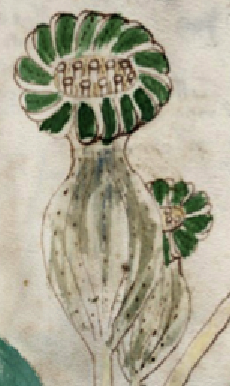 One detail that had me wondering was the little bumps on the seed capsule. They’re completely unlike Papaver, but they’re not entirely like Nuphar or Nymphaea, which have a depression in the center. Then I remembered another VMS plant in which the seeds inside a pod had been exaggerated, so I wondered if this was the same idea.
One detail that had me wondering was the little bumps on the seed capsule. They’re completely unlike Papaver, but they’re not entirely like Nuphar or Nymphaea, which have a depression in the center. Then I remembered another VMS plant in which the seeds inside a pod had been exaggerated, so I wondered if this was the same idea.
Nuphar and Nymphaea have very different internal structures to the seed capsules than poppies.
- Poppy is a land plant. The seeds roll around freely inside the capsule chambers and are dispersed by wind when the capsule dries, or they drop off and get stepped on or fall out through the holes near the top, under the edge of the rosette.
- Nuphar and Nymphaea are aquatic plants and the seeds are imbedded in a spongy matrix, rather than rolling around freely. This means if you cut across the top, you will see regular rows of seeds within a lighter medium. As the capsule ripens, it is exposed to water, which erodes it, gradually releasing the seeds (some of them ripen under water). Water lilies aren’t as wind-dependent as the Papavers.
I don’t know if this explains the bumps on the top, I’ll continue to think about it, but it’s one possibility.
And now to the most interesting part…
The Root Heads
 I have difficulty explaining the heads if this is Papaver. Why two of them? Most poppies have tap roots, so why wasn’t it drawn with one head and a long narrow root? Why do the thickest roots stretch to the sides? Are they meant to suggest rhizomes that propagate like long snakes under ground or water? If so, they are more similar to water lilies.
I have difficulty explaining the heads if this is Papaver. Why two of them? Most poppies have tap roots, so why wasn’t it drawn with one head and a long narrow root? Why do the thickest roots stretch to the sides? Are they meant to suggest rhizomes that propagate like long snakes under ground or water? If so, they are more similar to water lilies.
Are these monks, as per my original impulse. Or are they moons? What are the pointy parts—are they water droplets with faces? Could this indicate an aquatic plant?
Depending on which source you consult, the moon is said to be the ruling body for both poppies and water lilies. A water lily picked on the full moon was used in spells to attract a lover, but this is in recent writings, and I haven’t been able to confirm if this accurately reflects a medieval spell.
Maybe the roots have some other meaning. Various parts of water lilies are eaten, and some have sedative or narcotic effects. Monks and nuns used them to suppress their sexual desires. When prepared as an alcohol tincture, they were an-aphrodisiacs. Could this account for the heads with shorn tresses? Are they tonsured monks?
Summary
Plant 33r is not a perfect match for water lilies. It’s close, much closer than Papaver, but why would the points on the leaves be exaggerated, and why are there bumps in the tops? Is it a really bad drawing of poppy?
Are there other explanations for the heads besides monks or moons or water droplets? I’m still mulling this over, but for now, the best ID I have is one of the Nuphars or Nymphaeas, both of which are widespread and well-known in the Middle Ages.
J.K. Petersen
© Copyright 2013 J.K. Petersen, All Rights Reserved
Postscript 12 May 2019:
To make the similarities and differences between these plants more clear, I created a chart with a few samples (click to see it full-sized):
Large Plants – Folio 32v
Large Plants – Folio 32r
Plant 32r is an upright plant occupying a large portion of the page from bottom to top, interwoven with what appear to be two main blocks of text. The top “block” (assuming the lines on the left are associated with those on the right) is broken across the top of the plant.
The main plant colors are green leaves, brownish stems and blossoms, and alternating blue and clear for the scaly portion holding the blossoms.
The colors are somewhat crudely (hastily? impatiently?) applied but stay mostly within the lines. The blue, in particular, is “dabbed” with less concern for maintaining shape. This does not appear to be because of the space limitation since the blossoms, which are equally small, are more carefully rendered. Perhaps the blue pigment was drier and harder to spread smoothly.
Details
Leaves: Opposite, roughly between elliptical, cordate and deltate. There are smaller, somewhat irregular pairs under some of the larger leaves. The petioles are fairly short. The margins are serrated or irregular.
Flowers: Scaly/overlapping flower head, with a blossom protruding from the end that might have roughly three petals (or three petals visible from one side or may be trumpet-shaped).
Stems: Slender and regularly branching. Plant 32r shows a strong overall symmetry.
Roots: There appears to be a tap root with fine rather than thick tendrils, possibly asymmetric, or perhaps directional (more about this below). Most VM 408 plants are rendered in brown or brick red.
Prior Identification
Edith Sherwood has identified this as Speedwell (Veronica triphyllos), but V. triphyllos differs from Plant 32 in a number of ways:
- V. triphyllos has small roughly palmate (somewhat digitate) leaf pairs at regular intervals along the stem (see illustration below), they are not the larger more elliptical/deltate leaves of Plant 32r.
- V. triphyllos blossoms don’t emerge out of a scaly head in the same manner as 324. There are sometimes clusters of leaves at the end of V. triphyllos stems, but the parts of the cluster are more distinctly separate and pointed than the heads of Plant 32r.
- The branching stems are not as symmetric as 32r.
- The pistils of V. triphyllos blossoms are quite prominent and might perhaps have been included by the VM illustrator.
- V. triphyllos stems and leaves are hairy and this too might have been included if the illustrator were trying to represent V. triphyllos.
I don’t see V. triphyllos as a good match for Plant 32r.
The palmate, somewhat digitate, leaves of Veronica triphyllos are distinctly different from Plant 32r. V. triphyllos is not as symmetrically branched as Plant 32r. The flower heads of V. triphyllos are more discrete and separate than the scaly heads of 32r.
Other Possibilities
Examples of possibile candidates for Plant 32r that more closely resemble the VM plant include the following:
Melampyrum cristatum (left) doesn’t appear to be close enough for consideration. The “scaly” section has long protruding tips and the leaves are too narrow but the pipe-shaped blossoms emerging from the end, the evenly branching stems and opposite leaf arrangement caught my eye. Melampyrum nemorosum (second left) has wider leaves but a more spiked and upright appearance.
Coridothymus capitatus is a medicinal plant mentioned in manuscripts like Materia Medica but the leaves are very small and not branched in the same way as 32r, and the blossoms at the tip of the flower head are more numerous than Plant 32r.
Thymus moroderi and Thymus serpyllum (middle right) are similar in structure to 32r, but the leaves are much smaller in proportion to the flower heads.
The Indian plant, Strobilanthes callosus, has some of the characteristics of 32r, but the blossoms are larger and are more numerous along the stems and the “scaliness” is not as prominent. Strobilanthes nutans is tempting, it has trumpet-shaped blossoms emerging from scaly flower heads and more closely matches 32r than S. callosus, but the branches tend to trail and the flower-heads to nod, while the Voynich plant appears to be upright. Strobilanthes dyerianus is more upright, but the blossoms protrude much farther than Plant 32r blossoms.
Possible Closer Matches
Agastache foeniculum (Anise Hyssop) and Agastache rugosa have longer, bushier flower heads and more pointed leaves than 32r. Agaste urticifolia (left, courtesy of Dcrjsr, Creative Commons), is a fairly close match for the 32r leaves, but it has more plume-like flower heads.
Stachys silvaticus (Hedge Woundwort, right) might be considered, it fits the overall proportions better than the previous examples. However, the leaves and flower heads are more tiered than the single flower head of 32r.
Plants of the mint family (Mentha), tend to have bushier flower heads than 32r and they rise in a tall spike, sometimes with several tiers. The leaf tips are a little more pointed than 32r.
The blossoms of Nepeta cataria (Catmint, second right) tend to be more numerous than 32r but N. cataria might be worthy of consideration.
The Flower Heads
As far as matching the 32r flower head, lavender appears to be closer than most of the above.
Lavender (middle) has flower heads simlar to 32r, with scaly, overlapping protrusions, and darker smaller blossoms within some of the “scales” and, in some varieties, like French lavender (right, Blackwell 1730s), a single larger blossom emerging from the end. However, the leaves are very narrow and linear, and not as distinctly opposite, compared to Plant 32r. The heads are a good match—the leaves are not.
Which brings us to Prunella vulgaris, also known as Self-Heal—a plant with significant stature as a medicinal plant in the Middle Ages.
The leaf shape and general leaf-and-stem arrangement of P. vulgaris are a better match for Plant 32r, as are the scaled flower heads with protruding blossoms at the ends of the stems. The antique botanical print on the right shows tiny extra leaves reminiscent of the small leaves or bracts in Plant 32r. The distinction between the tiny florets within the “scales” and the end blossom is not as distinct as in the Blackwell French lavender illustration shown earlier, but overall, 32r is closer to Prunella or Catmint than to lavender.
Prunella (Self-Heal) is not an assured identification, but it is a step in the right direction and is a much closer match to 32r than Veronica triphyllos. Oddly, on a related note, Sherwood has identified Plant 14v as Stachys monnieri (Lamb’s Ear, Alpine Betony) even though the Voynich plant, 14v, is shown with large, heavily serrated, almost frond-like leaves, and S. monnieri has heads and leaves similar to Prunella. S. monnieri does have larger and more deeply serrated leaves, but even so, it is closer to 32r in general proportion of flowers to leaves than Plant 14v.
Roots
Also, as a point of interest, some of the old botanical illustrations (e.g., W. Baxter, 1837) show Prunella roots in a sideways orientation (left) and since the root tendrils come out of the root going down, it sometimes looks asymmetric like 32r (imagine it turned 90° as in the example in the middle so that it streams out of the main root to one side). This might be a stretch, to try to justify the arrangement of 32r roots but it’s something to think about. Some plants propagate by sending out root shoots to the side under the ground and perhaps this was the Voynich illustrator’s way of symbolizing it.
Summary
The above examples are not exhaustive. Each of the aforementioned plants may have relatives that more closely match Plant 32r and likely candidates from other species have been omitted for the sake of brevity, but it charts a path, based on details of the VM plant, to some of the more likely possibilities and explains why Sherwood’s choice of Veronica triphyllos seems unlikely.
Plant 32r Veronica triphyllos (Sherwood) Catmint Prunella
This is not a definitive identification but, for now, I’m leaning toward Prunella or one of its relatives as the inspiration for Plant 32r.
Posted by J.K. Petersen
Addendum: I’m not sure how the links to all the pictures disappeared (the pics were still visible in edit mode) but I have done my best to restore them to the originals. The article doesn’t make sense without them.

